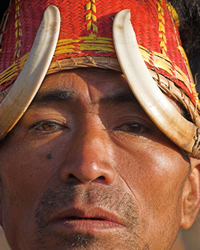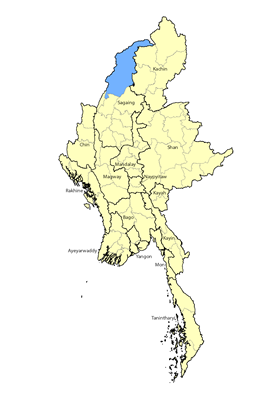The Drancyi have a proud self-identity and speak their own language but have never appeared on any list of the world's people groups. They call both their tribe and their language Drancyi, but other groups in the area call them a variety of names, including Ransi, Yaanti, and Yangbaanvang. They are one of several dozen different tribes in northwest Myanmar, each speaking its own language or dialect and possessing a sense of communal identity. Most Drancyi people are not Myanmar citizens. A 2014 study found that nearly six out of ten people in Lahe Township had no identity card, making it difficult for them to travel outside their home area to secure employment.
Location: With a population of approximately 2,400 people, the Drancyi tribe inhabits villages within Lahe and Khamti townships in northwest Myanmar's Sagaing Region. The main concentration of Drancyi live in over 110 households in Ransi village near the town of Dunghi (also called Donhee). Others are scattered throughout other parts of Lahe and in neighboring Khamti Township. The Sagaing Region has been a hotbed of anti-government resistance since the 2021 coup and subsequent civil war. Government forces have used airstrikes to bomb civilians, resulting in several massacres.
Language: Drancyi is part of a branch of the Tibeto-Burman linguistic family. Initial studies suggest that Drancyi is most closely related to Gaqha, Gaqlun, and Raraq, but it varies significantly from other languages to the point that the Drancyi must speak Burmese to be understood when meeting most other people.
People have lived in Sagaing for at least 2,000 years, with the original inhabitants believed to be the now-extinct Pyu people, who probably lent their name to the country of Burma. Some claim that when the first British officer arrived in the 18th century, he asked a local what the name of the country was. He replied, “Pyu-mar,” meaning “the land of the Pyu.” The officer recorded the response as “Burma.” It was widely known by that name for the next two centuries until the government changed the name in 1989 to “the land of the Myan” (Myanmar). Sagaing remained largely the domain of independent tribes until the mid-11th century when, during his reign from 1044 to 1077, King Anawrahta brought the region into the Pagan Kingdom and under Burmese control for the first time.
Lahe Township has an extremely young population, with 40.8 percent of people aged 14 years or younger at the time of the 2014 census.3 The literacy rate is low, with only 20.6 percent of people aged 15 and over able to read, including only 16 percent of females. Nearly nine out of ten adults in Lahe had never attended any level of school. Despite these figures, some determined Drancyi teenagers have gone to Nagaland and other parts of India to pursue higher education.
In the past, the Drancyi were animists who sought to keep disaster and starvation far from their community by placating a host of evil spirits. Ceremonies were designed “to protect and increase crops…. Some believed that good souls go to a place toward the sunrise, while evil souls were destined for a terrible place in the direction of the sunset.”5 Tired and frustrated of living in poverty and slavery to the spirits, the Drancyi people embraced Christianity en masse in the 1960s, and today their entire population are Christians.
Most Drancyi Christians are members of Baptist churches, with a few attending Catholic and Church of Christ fellowships. Like almost all other tribes, the Drancyi have been disadvantaged by having no Scriptures available in a language they can understand, and no Gospel video or audio resources have ever been produced in their vernacular. To compensate, the churches have sent some of their brightest young men across the border to attend seminaries in Nagaland in the hope they will return home and become faithful church leaders.
Scripture Prayers for the Drancyi in Myanmar (Burma).
| Profile Source: Asia Harvest |











